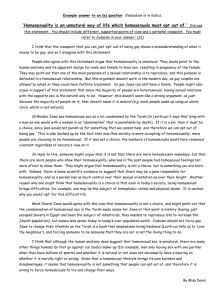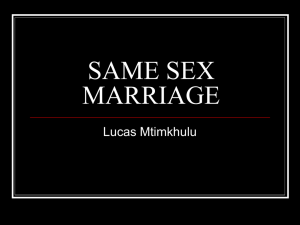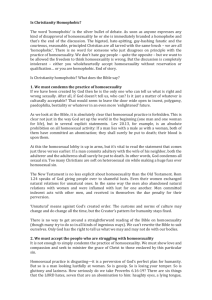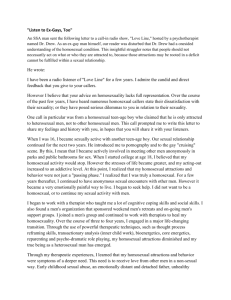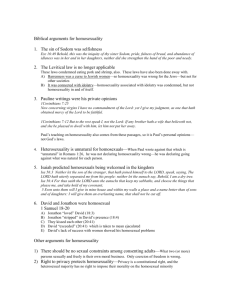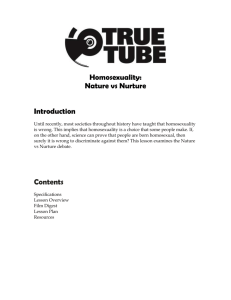The Great Gay Gene Debate
advertisement
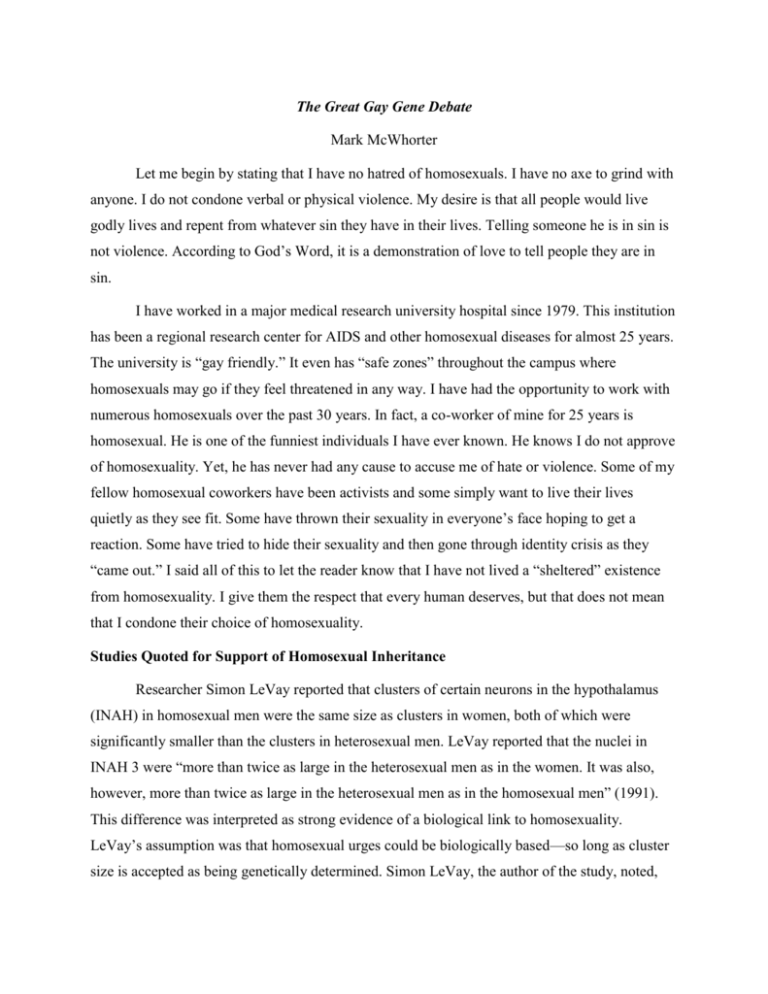
The Great Gay Gene Debate Mark McWhorter Let me begin by stating that I have no hatred of homosexuals. I have no axe to grind with anyone. I do not condone verbal or physical violence. My desire is that all people would live godly lives and repent from whatever sin they have in their lives. Telling someone he is in sin is not violence. According to God’s Word, it is a demonstration of love to tell people they are in sin. I have worked in a major medical research university hospital since 1979. This institution has been a regional research center for AIDS and other homosexual diseases for almost 25 years. The university is “gay friendly.” It even has “safe zones” throughout the campus where homosexuals may go if they feel threatened in any way. I have had the opportunity to work with numerous homosexuals over the past 30 years. In fact, a co-worker of mine for 25 years is homosexual. He is one of the funniest individuals I have ever known. He knows I do not approve of homosexuality. Yet, he has never had any cause to accuse me of hate or violence. Some of my fellow homosexual coworkers have been activists and some simply want to live their lives quietly as they see fit. Some have thrown their sexuality in everyone’s face hoping to get a reaction. Some have tried to hide their sexuality and then gone through identity crisis as they “came out.” I said all of this to let the reader know that I have not lived a “sheltered” existence from homosexuality. I give them the respect that every human deserves, but that does not mean that I condone their choice of homosexuality. Studies Quoted for Support of Homosexual Inheritance Researcher Simon LeVay reported that clusters of certain neurons in the hypothalamus (INAH) in homosexual men were the same size as clusters in women, both of which were significantly smaller than the clusters in heterosexual men. LeVay reported that the nuclei in INAH 3 were “more than twice as large in the heterosexual men as in the women. It was also, however, more than twice as large in the heterosexual men as in the homosexual men” (1991). This difference was interpreted as strong evidence of a biological link to homosexuality. LeVay’s assumption was that homosexual urges could be biologically based—so long as cluster size is accepted as being genetically determined. Simon LeVay, the author of the study, noted, "It's important to stress what I didn't find. I did not prove that homosexuality was genetic, or find a genetic cause for being gay. I didn't show that gay men were born that way, the most common mistake people make in interpreting my work. Nor did I locate a gay center in the brain" (Nimmons, 1994, p. 64). The study did not show that the hypothalamus was different at birth. The difference may have been caused by the homosexuality. Researchers did not get full histories from subjects regarding medical history. Thus some things had to be assumed. Of note is that all 19 homosexual subjects died of AIDS. Did AIDS contribute to the findings? The study has never been reproduced. In fact, we now know that neurons can be generated in certain areas of the brain by particular activity. It must also be pointed out that the main researchers were homosexuals. A group led by Dean H. Hamer of the National Cancer Institute allegedly linked male homosexuality to a gene on the X chromosome (two years after LeVay). His team investigated 114 families of homosexual men. Hamer and his colleagues collected family history information from 76 gay male individuals and 40 gay brother pairs as they searched for incidences of homosexuality among relatives of gay men. Because many of the families with a prevalence of homosexual relatives had a common set of DNA markers on the X chromosome, Hamer’s group assumed a genetic etiology. Of the 40 pairs of homosexual brothers he analyzed, Hamer found that 33 exhibited a matching DNA region called q28—a gene located at the tip of the long arm of the X chromosome. In summarizing their findings, Hamer and colleagues noted, “Our experiments suggest that a locus (or loci) related to sexual orientation lies within approximately 4 million base pairs of DNA on the tip of the long arm of the X chromosome” (1993). Dean Hamer, author of the "gay gene" study, stated, "We knew that genes were only part of the answer. We assumed the environment also played a role in sexual orientation, as it does in most, if not all behaviors...” (Hamer and Copeland, 1994, p. 82). Hamer further emphasizes, "Homosexuality is not purely genetic...environmental factors play a role. There is not a single master gene that makes people gay...I don't think we will ever predict who will be gay" (Mitchell, 1995). When asked if being homosexual was solely rooted in biology, his reply was absolutely not. "From twin studies, we already know that half or more of the variability in sexual orientation is not inherited. Our studies try to pinpoint the genetic factors...not negate the psychosocial factors" ("New Evidence of a 'Gay Gene,'" by Anastasia Toufexis, Time, November 13, 1995, vol. 146, Issue 20, p. 95.). Hamer did not test heterosexuals to see if they had the markers. Thus, there was no adequate control group for the study. Correlation does not indicate causation — as was also noted regarding LeVay’s study. Hamer's study has not been reproduced either. The main researchers of this study were also homosexuals. A 2006 Swedish study of lesbians was reported in the world press as showing a physical basis for lesbian behavior when exposed to female hormones. Dr. Ivanka Savic of the Stockholm Brain Institute stated, “This is incorrect and is not stated in the paper.” The study simply showed that lesbian women reacted differently than heterosexual women. This may mean that the reaction is a result of the homosexual behavior rather than the origin of the behavior. The Bailey and Pillard twin studies supposedly demonstrated genetic base of homosexuality. Yet the study had several methodology problems including control group. They did not show that 100% of identical twins were homosexual. Nearly one half were not homosexual nor had tendencies toward that lifestyle. If the gene controlled it, this should not be the case. The study also showed that more adopted brothers were homosexual than non-identical biological brothers! Again, the main researchers were homosexuals. Psychiatrist Robert Spitzer, a prominent member of the American Psychiatric Association and historic ally of gay activists, provides insight into how activism has replaced science in the national organizations. He notes, "There's a gay-activist group that's very strong and very vocal and recognized officially by the American Psychiatric Association. There is nobody to give the other viewpoint...There may be a few people...but they don't talk" (Spitzer, 2004). Friedman and Downey, psychiatric researchers at Columbia University, offered a strongly worded conclusion opposing the essentialist argument: "At clinical conferences one often hears...that homosexual orientation is fixed and unmodifiable. Neither assertion is true...The assertion that homosexuality is genetic is so reductionistic that it must be dismissed out of hand as a general principle of psychology" (2002). Neil Risch and his coworkers admitted there is little disagreement that male homosexual orientation is not a Mendelian trait. In fact, a priori, one would expect the role of a major gene in male homosexual orientation to be limited because of the strong selective pressures against such a gene. It is unlikely that a major gene underlying such a common trait could persist over time without an extraordinary counterbalancing mechanism (1993). Evan S. Balaban, a neurobiologist at the Neurosciences Institute in San Diego, noted, "The search for the biological underpinnings of complex human traits has a sorry history of late. In recent years, researchers and the media have proclaimed the 'discovery' of genes linked to alcoholism and mental illness as well as to homosexuality. None of the claims...has been confirmed" (as quoted in Horgan, 1995). Brian Mustanski and others published a study in 2005, looking at three non-X chromosomal new regions of interest (7q36, 8p12, and 10q26). Their study found no significant relationship between DNA regions and self-reported sexual orientation. The findings show that statistical significance fell below normally accepted ranges for criteria of suggested linkage. Individuals who have partners of the same sex are biologically unable to reproduce (without resorting to artificial means). Therefore, if an alleged “gay gene” did exist, the homosexual population eventually would disappear altogether. The “gay gene” being a normal condition would not make sense from an evolutionary standpoint, much less from a Biblical standpoint. Is It Possible to Change Behavior? The National Association for Research and Therapy of Homosexuality (NARTH) released the results of a two-year study stating: “Before treatment, 68 percent of the respondents perceived themselves as exclusively or almost entirely homosexual, with another 22 percent stating that they were more homosexual than heterosexual. After treatment, only 13 percent perceived themselves as exclusively or almost entirely homosexual, while 33 percent described themselves as either exclusively or almost entirely heterosexual” (see Nicolosi, 2000, 86:1071). The study also reported that although 83 percent of respondents indicated that they entered therapy primarily because of homosexuality, 99 percent of those who participated in the survey said they now believe treatment to change homosexuality can be effective and valuable (p. 1071). These data are consistent with the ongoing research project of Rob Goetze, who has identified 84 articles or books that contain some relevance to the possibility of sexual orientation change (2004). Of the data reported, 31 of the 84 studies showed a quantitative outcome of individuals able to change sexual orientation. Dr.Francis Collins, a leading DNA scientist in the world, stated, “There is an inescapable component of heritability to many human behavioral traits. For virtually none of them is heredity ever close to predictive.” Heritability is not to be confused as inevitability. Environment can influence gene expression, and free will determines the response to whatever predispositions might be present (National Association for Research & Therapy of Homosexuality, April 4, 2007). To be inherited means "directly determined by genes," with little or no way of preventing or modifying the trait through a change in the environment. This does not mean that genetic makeup of a person might give a predisposition to certain likes or dislikes. However, predisposition does not mandate the behavior. I may be predisposed to like eating spinach, but that does not mean that I must eat spinach. Consider the logical end of such genetic determinism. The pedophile claims genetic source of his pedophilia. Thus, he cannot help but be a pedophile. And since it is genetic and not free will choice, no one has the right to say pedophilia is wrong. It would be unjust to have laws against pedophilia since it is not a choice but a natural act. The terrorist claims genetically he cannot help but hate and murder. It is what he “is.” Thus, no one has the right to restrict his terrorism or to condemn him for his actions. Genetic determinism leads to societal chaos. Space for this article does not allow a discussion of the psychological and physical illnesses associated with homosexuality. Such is well documented along with the shortened life expectancy of those actively engaged in homosexuality. If you view it from a purely evolutionary worldview (which I do not), it could be argued that encouraging homosexuality would be encouraging the propagation of the weaker of the species. Even from a secular medical viewpoint, it is without doubt an unhealthy biological and anatomical activity for the male body. If homosexuality is determined by genetics, it would need to be acknowledged that it is not a good genetic formulation--for it is in opposition to what is biologically and psychologically healthy for the human. Having spent millions of dollars, using hundreds of labs to work out the human genome, the infamous “Gay gene” has remained elusive and non-existent.
